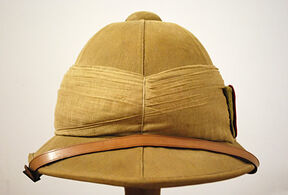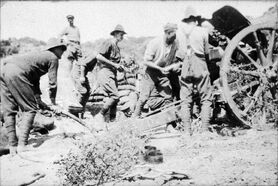EQUIPMENT FOR A NEW ZEALAND SOLDIER
A New Zealand soldier went to war in August 1914, wearing the 1902 Pattern Service Dress tunic and trousers. There were two breast pockets for personal items and the soldiers AB64 Pay Book, two smaller pockets for other items, and an internal pocket sewn under the right flap of the lower tunic. Rifle patches were sewn above the breast pockets, to prevent wear from the webbing equipment and rifle. Shoulder straps were sewn on and fastened with brass buttons, with enough space for a brass regimental shoulder title.

1902 pattern used by NZ and British forces
The Pith helmet is a lightweight helmet made of cork or pith, with a cloth cover, designed to shade the wearer's head from the sun. They wore these till 1815 until the Brodie helmet came in use which was made of steel. The ionic 'Lemon Squeezer' hat, worn for non combat situations, was adopted by the Wellington Regiment about 1911 and became general issue for all NZ units during the later stages of WW1

Pith Helmet

Brodie Helmet

"Lemon Squeezer" The regiments were indicated by the coloured bands
The were equipped with M1-grand rifles, Lee Enfield rifles, hand grenades, and usually some spare ammunition. The men with a good shot were able to get a sniper rifle but were only usually used on special missions.

M1 Rifle
Other weapons that the NZEF would have been familiar with were the Vickers machine gun and the Howitzer field gun which could fire 2 rounds of 290 lb (134 kg approx) shells a minute.

British Vickers gun crew with Gas masks

NZ Vickers gun crew in Palestine

Howitzer at the Western front. NZ troups

Howitzer at Gallipoli. NZ troups
The first use of poison gas on the Western Front was on 22 April 1915, by the Germans at Ypres, against Canadian and French colonial troops.The initial response was to equip troops with cotton mouth pads for protection. Soon afterwards the British introduced the Black Veil Respirator.This mask offered protection to the eyes as well as to the respiratory system. Soon enough many New Zealand troops were equipped with them.